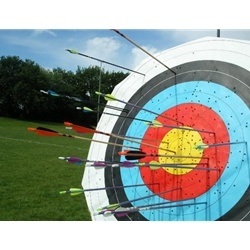
Archery has been an important part of society since the earliest history. It was used for hunting even in prehistoric times, and it became an important part of community defense in the Middle Ages. Recently, it has been the focus of many popular depictions, such as in the movie Brave. More and more people of all ages are getting involved with this exciting sport, and many are also learning about guns and gun safety.
Is Archery Right for You?
In the medieval period, it was said that if you wanted to make a family of good archers, you had to start with Grandpa. The skills an archer needed were often passed down through generations. In England and France, free men were required to practice with the bow on a regular basis. Even if you don't practice every day, though, you can still be a competent sport archer. Doing so calls for upper body strength, hand-eye coordination, patience, balance, and dexterity. It's important to be able to breathe deeply and evenly before firing, steadying every part of your body. If you have even basic skills in these areas, you can develop with time.
Types of Bows
There are two major types of bows: the recurve bow and the compound bow. The recurve bow is the most common: It has a traditional form very similar to the bows that have been used around the world for millennia. It consists of only a bowstring and body, the latter typically made from fiberglass or carbon. Compound bows have a smaller body incorporating a sophisticated modern system of pulleys and weights. They are more powerful and easier to draw but generally not any more accurate. They are also not supported in all sporting events or tournaments.
Other Equipment You Might Need
Aside from a bow, there are several other accessories you may need to become a hobbyist archer. If you join a club, it may provide some equipment, but it's important to find what works best for you. Flat athletic shoes will help you maintain your balance. Your outfit should be close-fitting, yet not so tight as to restrict movement. You will need both an arm guard for your non-dominant hand and a finger tab or gloves to protect your fingers from the bowstring. If you are shooting outdoors, a pair of binoculars can give you a better sense of where your arrow ended up.
Types of Competitions
There are many different kinds of events for novice and expert archers. The most common type is target archery, where you fire at a target from a specified distance. This event tests your accuracy, balance, and control, just like the equivalent event with firearms. Bows, of course, aren't guns and can take more strength and endurance to fire, so even a relatively simple event can be a test of the archer's willpower and endurance.
Field archery is practiced outdoors, generally with each target set on a slope, either downhill or uphill. Archers in the field have to account for a lot of hiking, so the physical challenge is often even greater than in other types of shooting competition. Last, but certainly not least, is 3-D archery, where competitors fire at three-dimensional foam animals. These are set up in heavily wooded or hilly areas that offer challenging shots.
Bow Hunting
Many sport shooters decide to try their hand at hunting as well. As with gun safety, the archer must be very careful to maintain vigilance over their equipment and personal situation at all times. Using a bow to hunt often requires special permits and an intricate knowledge of the terrain. It is important to align a shot in such a way that an animal is killed cleanly, with minimal suffering and without the opportunity to lash out violently. Although it may not be as complex as gun safety, archers should consider taking a special course before braving the great outdoors.